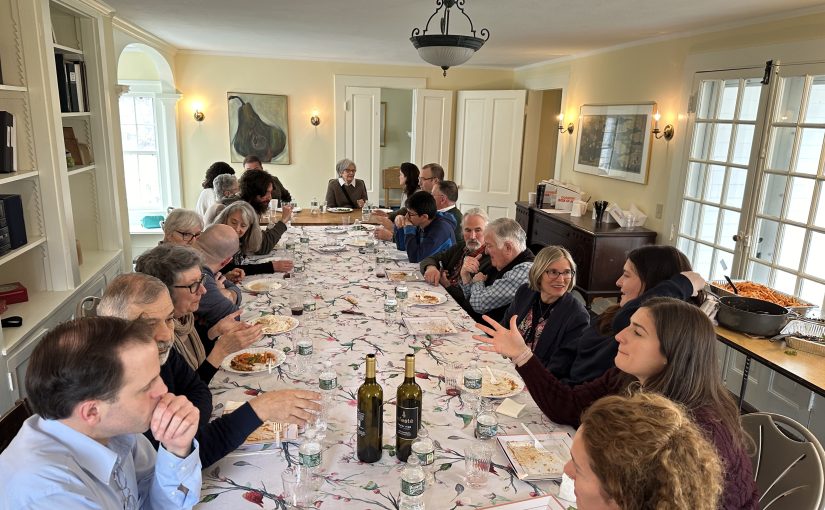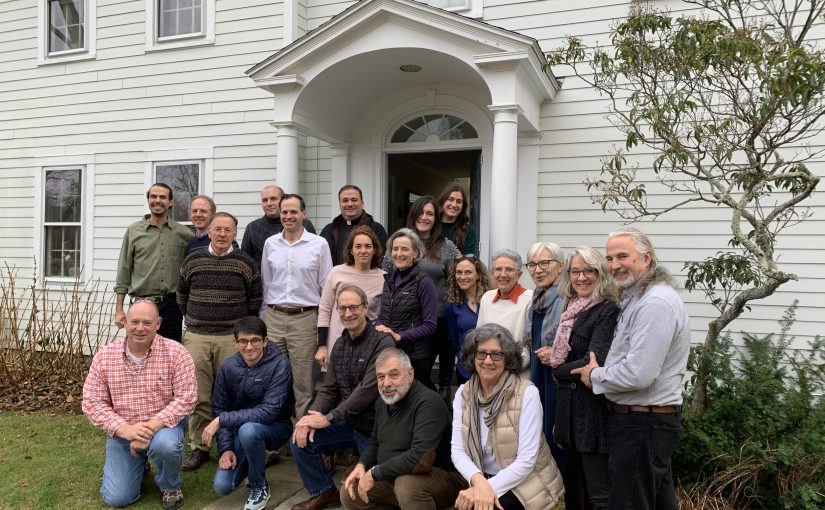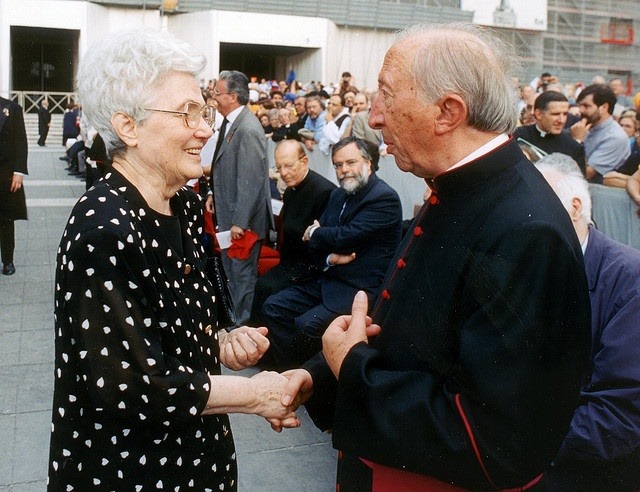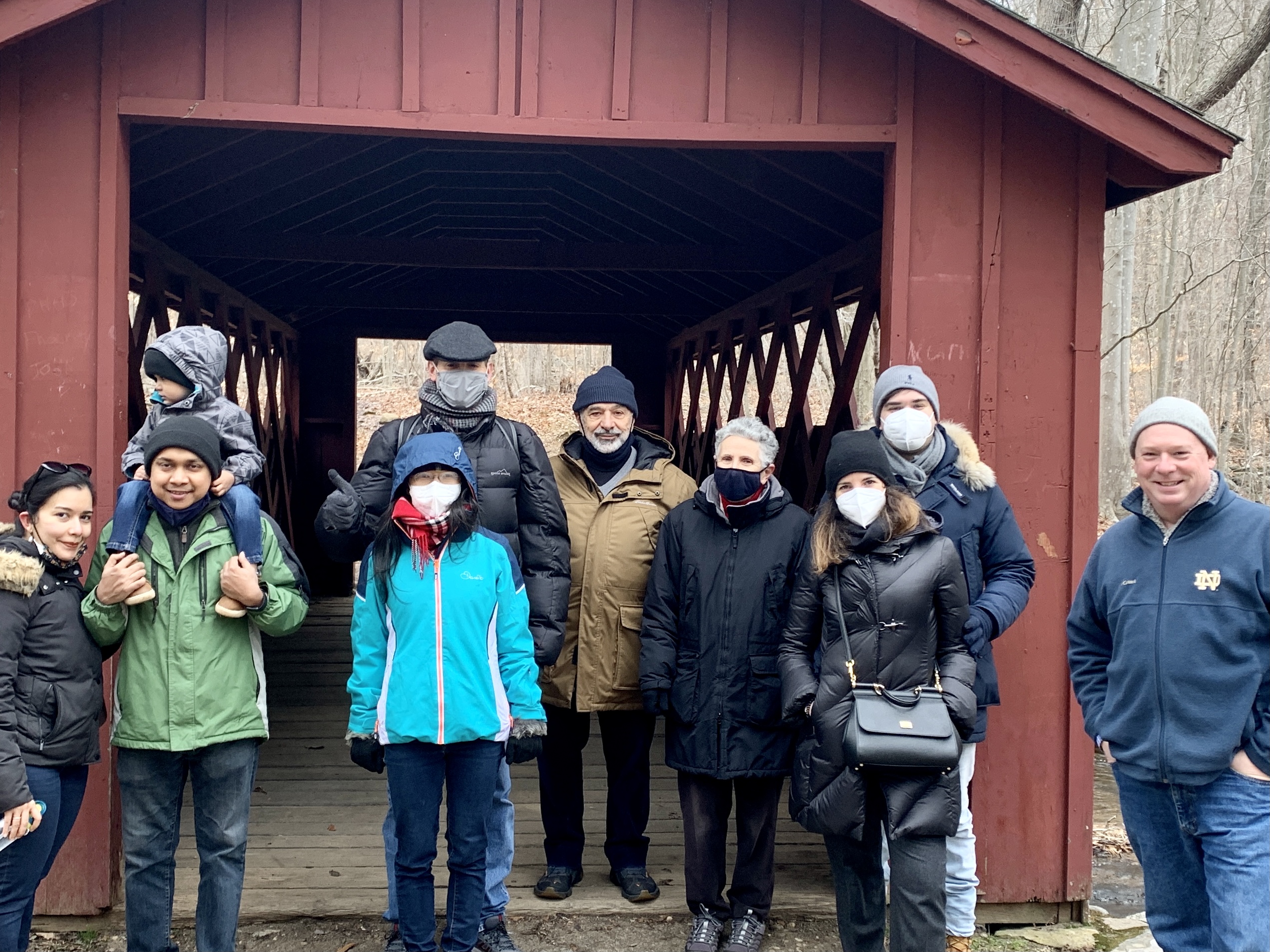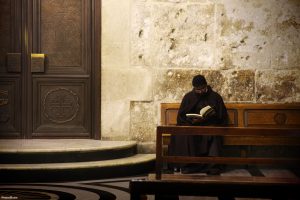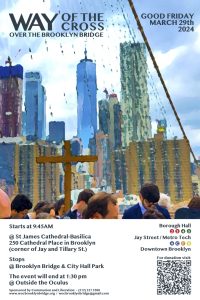
Category: Communion & Liberation
Dynamic of Faith, Faith as a journey
Today the privilege of spending time with friends who share with me the journey of faith. Lent is a particular time to step back to be rejuvenated in the joyfulness of loving. It seems to me that Lent and for that matter, the whole of Christian life, is a journey in loving joyfully. The cynics among us are critical of this line of thinking because it sounds wishy-washy. On the contrary, it is serious path to deepen not only the relationship with the Lord, but also living with others.
What is faith? How is faith understood? Today’s retreat director, Fr. Luis, made a key point: Faith is a relationship with an alive presence—that of Jesus. It is a dynamic of Faith; we know deeply that faith is a journey. So, I can say with conviction that my relationship with Jesus Christ (and the Church and community) 5 years ago is vastly different from what it is today.
What faith is not is one that is not a creed that I can have or lose. A barometer or something that can be bought or sold. Faith is not a thing one can lose. We often hear that people lose their faith, or that faith has dried up, or that faith has been ruined by another (think of those victims of abuse). What is true that one can experience a lessening of the awareness of the life of faith informing our person and how we live. Faith is, rather, a way of seeing, a way of knowing, and a way of living. Once Jesus Christ has entered my life he is always with me. The covenant will never be altered; no matter what our behavior may or may not be. We belong to Jesus who never walks away. Belonging is what revealed in Scripture and in tradition; it is way of being in relation even if we don’t feel like being in relationship with the Lord.
The journey of faith is shown in the Scriptures in powerful ways. Think of how the apostles first met the Lord. Think of the Samaritan woman at the well. Think of the parable of the mustard seed which contains hope because it contains the germ of life.
What’s the journey about? Some notes.
1. Faith as loving recognition. (Generating Traces, p. 22)
Recognition is more than intellectual assent. Recognizing moves me. It’s a loving approach. It comes as a surprise, unscripted. There’s a correspondence or a convergence with the heart. This correspondence happens with Jesus in seeing & being with him. It’s a loving recognition, it’s an affection.
Faith isn’t about rules. The emphasis on a rule based Christian faith follows a false premise. First one needs to be converted and conversion is less about following the “rules” than it is entering into friendship with the God who is certain. Otherwise it’s empty and pretentious. We try to give people what they don’t need by insisting on a rule based faith. This is certainly not what is revealed in Scripture. A conversation about canon law, the moral life, theological data is another conversation. At this moment I know that the God I know and love is a God who makes exceptions for me; he is the God of the perpetual second chance (think of sacrament of Confession and of the Eucharist).
Love can be manifested things like, Be kind to yourself.
I know I have a desire to be loved. Having a claim on the love of others is a true desire and event. We who have encountered Christ have written the religious sense. What we often hear, however, is “Don’t get involved.” Not quite the Christian way. This person has the same desire to be loved but they put a brake on receiving love.
2. Lenten is an Experience as a surprise. To be human to exist with recognition of an absence to be fulfilled. Prayer, fasting, works of charity are tools for the Lord to fill the absence that these tools create. We need something that will fulfill us.
St Paul’s letter to the Colossians tells us that Christ is the image of the invisible God.
The infinite love of God shapes our life because our humanity is taken seriously. God gives me someone to love and to be loved by that person. This is how God reveals himself. But more importantly we come to ask what it means to be open to the Other.
Prayer allows Christ to enter our lives. Allow him to grow in us.
Now we come to getting a handle on what the liturgical season of lent is for the Catholic. So many preachers and teachers make Lent out to be drudgery: a 40-day period difficult time of renunciation and penance. Don’t get me wrong. Lent is a serious time of changing the ugliness of sin in my experience by Grace into something new. But it is not my work. Lent is the time in which we ask Christ to work in me.
Lent’s work is keeping memory active.
Lent as a time of memory. Our personal experience of salvation. Memory keeps us focused in the essential movements of Grace. It is how recognize, how we remember how God actually works here and now. How do you recall daily the events of God you in your life? How do you remember? What are the steps? Silence. Daily Silence makes sense of this life. It helps me to be present to the moment and not to be frivolous with that which is in front of me. Silence allows me to account for my heart. Silence brings awareness to life. It also allows Christ to enter into my heart.
3. Faith as missionary event.
If we allow Christ into our life, that we met him, we by nature to share the grace with others. We thus become a light in the world.
Witness to unity. Not to see how good they are but how Christ is operating in the person, in the world. To live communion.
John 17: as you sent me, I send them, that we are one.
Meeting friends
Earlier today approximately 75 members of Communion and Liberation gathered at the Cabrini Shrine in Washington Heights, NYC for the CL Beginning Day. Conversation, a witness, a lesson and the Vigil Mass for Sunday was offered. The Day was awash with an abundance of rain but spirits weren’t dampened. The U.S. Responsible for Communion and Liberation, Father Michael Carvill, FSCB, led the day.
The “nice thing” is that some members of weekly a zoom School of Community took a photo. Unique here is that many zoom meetings rarely afford the personal meeting of people. For me, this group is a mix of old and new friends; some friends live at a distance from New York so the photo becomes a sign of friendship.
An Advent Day with Communion and Liberation CT
Today we –two of Connecticut’s Schools of Community– tried something different: we had an Advent Day of Recollection in Connecticut!
The Nutmeg State has two Schools of Community that until recently had not too much to do with one another for no other reason that we just didn’t do much with each other. There are other excuses of distance, flavor, time, place, etc. However, what is not disputable has been the desire of several of us find a way for us to share in friendship, prayer, and a quest for unity in Christ!
A few people feeling convinced by the Holy Spirit to propose a Fraternal Day (which we had on October 30th) and the Advent Day of Recollection. It is fair to say that we attribute our desires for true communio to the Holy Spirit. Two moments of grace in 2022 have opened to us a vision of living the charism of Communion and Liberation more intently and with a deeper of purpose together. Nineteen people from the New Haven, Newtown and NY communities gathered for the Advent lesson, Holy Mass, the sacrament of Confession, lovely conversation and good food.
Lots of beautiful things happen through a convivium on several levels! As a gastropod I experience the convivial through good nutritious food because it is an experience of truth, beauty, goodness AND love; it is supreme only after being nourished by the Holy Eucharist. The emphasis may be on virtue of love. I recall that St Augustine taught a two table theology: the Holy Table and the dinner table –we are first “gathered at the banquet of the saints, … [and] we shall partake of the table of God’s mysteries” and “eat as is fitting.” Augustine also reminds us that we can eat well but digest poorly if we hear God’s word without putting it into practice (a paraphrase). Hence, I perceive the act of convivium as a real Catholic virtue! It is full of love and it is sacrificial.
And virtue needs to be extroverted: our friends in two different schools of community and a few others, lived this conviviality with a desire born out of the Eucharist.
Father Luis Hernandez, a priest of the Fraternity of St. Charles Borromeo working in the Boston area made the trip to be with us. He spoke with us, journeyed with us, laughed with us, loved us in a beautiful way. He reflected back to us that “It was also good for me to live the retreat of the Fraternity in a new and special way. It’s great to see how the Movement is different in its external aspects, but the same in its essence.”
The gift of place was made possible by my experience and relationship with the Promisek community in Bridgewater, CT. Promisek is a large piece of property in Litchfield County, Connecticut, held in stewardship as place of retreat, conversation, culture, and learning. People of diverse experience and history relate to the land of Promisek because it is a healing place, a place of deep personal and communal education, and a place of conversion rooted in the spirituality of the Rule of St. Benedict. A fitting connection of CL with Promisek exists because each are deeply informed and formed by the experience of Benedictine community: prayer, work, reading (study) and service. I always recognize that CL is truly a profound reality — an experience– of being sons and daughters of St. Benedict of Nursia. We may not say it that way on a corporate level, but we are this type of community. We are not monks or nuns or sisters, but we all relate to the charism of Luigi Giussani that depends on the recognition of the Lord’s Presence (the Incarnation) and the truth, beauty and goodness of creation.
More at another time on the content of the lesson.
The Faith of Fr. Luigi Giussani
Some of you may have seen this 2021 New Encounter presentation on the Servant of God Father Luigi Giussani. The staff of the NYE are making it available to us now.
A walk with friends today
Today was a beautiful January day in Connecticut. It was a most pleasant day to take a walk in Chatfield Hollow State Park (Killingworth, CT) with fellow friends who follow together in Communion and Liberation –an ecclesial movement in the Church. It’s been years since I’ve been in Chatfield Hollow. It was a melancholy day since we were together with our friends Razib and Nur and their son who are moving to California taking up a new mission in life in academic research and Evelyn who is headed back to work in Germany.
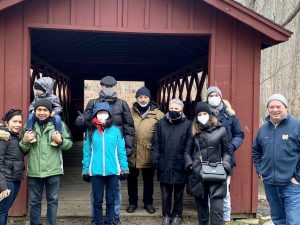
Our walk together reminded me of the feast day this past week of the Cistercian abbot Saint Aelred of Rievaulx who wrote extensively of friendship, particularly spiritual friendship. In fact, I had received a week ago a scientific biography of Aelred. Friendship is what binds us together in and for life. I am thinking of the classic definition by Cicero (De Amicitia 6.20): “Friendship is agreement in things human and divine, with good will (benevolentia) and charity (caritas).”
I am grateful for the friendship I share with so many, very particularly the friendship I share in Communion and Liberation.
Benedictine Spirituality II: The Master’s Instructions
The other day Part I in Benedictine Spirituality –Silence– given by Dom Boniface Hicks, monk of St Vincent’s Archabbey. Now in Part II of the Benedictine Spirituality, Dom Boniface explores The Master’s Instructions and our developing the sensitivity to the divine Presence. Where is your heart? Who is your God? How docile are you to the Lord’s promptings?
Those who follow Communion and Liberation and who live as Oblates will want to attend to this essay as there are points of convergence.
The Divine Presence – “The Master’s instructions”
Saint Benedict exhorts the monk to listen to the “Master’s” instructions. Who is the Master? On the one hand the Master is God. On the other hand, it refers to those who hold divine authority, such as the Abbot, but also to other authorities like parents, government leaders, teachers, elders, etc. In other words, God certainly instructs us directly, but He also instructs us through other people. This principle is repeated several times in the Rule of Benedict and it is an extremely important one for our Christian lives. Blessed Columba Marmion, OSB noted that the central theme of the whole Rule of Benedict is expressed in this idea found in Saint Benedict’s exhortation: “We believe the divine presence is everywhere…but beyond the least doubt we should believe this to be especially true when we celebrate the divine office” (RB 19:1-2).
The beginning of our awareness of God generally happens in a religious experience. Our communal celebrations, including the Mass, the Liturgy of the Hours and the other Sacraments, are important points of contact with God. It is critical that they be celebrated in a reverent and devoted manner. When these great times of prayer are beautiful and prayerful, they can be a cause for conversion. They should be bright with music, but balanced with times of silent reflection. They must be led confidently, reverently and prayerfully. These are the expectation of Saint Benedict when he reminds us that “beyond the least doubt we should believe” the divine presence is to be found in the divine office (RB 19:2). We must conduct ourselves in communal prayer and in the Church as we would conduct ourselves in the presence of a mighty ruler: “Whenever we want to ask some favor of a powerful man, we do it humbly and respectfully, for fear of presumption” (RB 20:1). Rather than carrying on raucous conversations or irreverent worldly activities in Church we must always act in a manner that reminds ourselves and also shows others that the One True God is present there in His Flesh reserved in the Tabernacle.
Saint Benedict expects us to develop a sensitivity to the divine presence by celebrating the liturgy well and taking the words of God on our lips seven times a day. “Let us stand to sing the psalms in such a way that our minds are in harmony with our voices (mens concordet voci)” (RB 19:7). Normally we first form words in our minds and then we speak them out with our voices. When we pray the psalms, however, the words are given to us to speak, but then they begin to form our minds. In this way, we allow the Word to form our way of thinking, which in turn can form our way of acting. After repeating the words of the psalms, the liturgical prayers and the readings from Mass, our hearts become more and more sensitive to the divine presence. We start to see his fingerprints and footprints all around us. We see His presence in the lives of others—in the lives of other monks and in the lives of the guests who come to the monastery. We see His Presence in our work. We see His presence in the sick members of the community. We see His presence in the Abbot. We see His presence at our meals. By becoming sensitized to the Word of God and taking on the mind of Christ, we start to see the divine presence everywhere in our lives.
This brings us back to the question, “Who is the Master?” The Master is God and we must take time in liturgical prayer and in personal prayer in order to begin hearing God and to sensitize our hearts to His presence. As we do that, however, we also start to see Him in everything. The monk is the one who arranges His day around repeated acts of attention to the divine presence. He regularly interrupts every other activity because “nothing is to be preferred to the Work of God” (RB 43:3). With his visits to the oratory and his celebrations of the liturgy of the hours at the center of his day, the monk makes acts of recollection throughout the rest of his day to renew his awareness of the divine presence. In Saint Benedict’s time it was already encouraged by St. John Cassian to recite the verse of Psalm 70: “God, come to my assistance. Lord, make haste to help me.” Cassian identified that verse as a defense against every attack of the Enemy and as a simple way to return one’s attention to God throughout the day. In the subsequent centuries, the Jesus Prayer served a similar purpose, “Lord Jesus Christ, Son of God, have mercy on me, a sinner.” With these brief prayers, the monk can bring his awareness of the presence of God, which is especially strong in the places of prayer, out into the rest of his life. He can learn to hear the instructions of the Great Master through every other little “master”. Even in sinful men or atheists, the prayerful monk can learn to be aware of the Presence of God.
Benedictine Spirituality I: Listen
Father Boniface Hicks, OSB, a Benedictine monk of Saint Vincent Archabbey in Latrobe, Pennsylvania. He is trained in computer science and in spirituality. Currently, Father Boniface is part of the formation team training men for the Catholic priesthood at his abbey’s seminary and the work of spiritual direction. Since I am interested in Benedictine Spirituality periodically you will see essays on this subject here on Communio. As a side note, those of us who follow Communion and Liberation ought to recognize a connection with what is said here and with what Father Julián Carrón has been teaching in months. That is, the importance of listening, centering on Jesus Christ as a Lord and Savior, and that silence is crucial method. How we respond to the Lord’s invitation to be in friendship with him requires us to be in relation to Him and listen to His promptings through prayer, fasting, alms-giving, sacred scripture, the worthy reception of the sacraments and knowing the faith.
What is said of monks is also true for the Oblates. Attend!
Introduction
“Listen my son to the Master’s instructions and attend to them with the ear of your heart” (Prologue 1). These are the first words Saint Benedict speaks to his monks through his Rule of life. The Rule of Benedict (RB) establishes three important spiritual attitudes already in the first verse. The first instruction is that Saint Benedict requires the monk to listen, which requires the monk to cultivate silence, humility and obedience. The second is that God, the Master, speaks to us—both directly and through those in whom He has invested authority, and even more broadly through the circumstances of reality itself. The third is that there is a kind of listening that one can only do and must do with the ears of the heart. In this post, we will reflect on the first part and take up the next two parts in the following posts.
Listening – “Listen, my son”
Listening is the foundational attitude of the monk and to do it well it requires silence, obedience, and humility. This explains the three chapters of the Rule on these principal monastic attributes—chapter 5 on obedience, chapter 6 on silence and chapter 7 on humility. All are necessary for listening: only the humble man listens, while the proud man believes he already knows everything; listening requires exterior silence to hear with the ears in one’s head and interior silence to hear with the ears of the heart, and obedience treats listening as a path of potential action, not merely a matter of taking in idle words.
Humility is a key theme throughout the Rule of Saint Benedict. The longest chapter in the rule (chapter 7) is devoted to the virtue of humility. Humility is expressed in the beginning of the rule as the call to listen. A person only listens when he believes he has something to learn. Otherwise, he will talk excessively, thinking everyone else has something to learn from him. That is why Saint Benedict warns the talkative man: “in a flood of words, you will not avoid sinning” (RB 7:57 quoting Proverbs 10:19). He also notes that when we think we know everything and never cease talking, we end up going in circles, never making progress: “A talkative man goes about aimlessly on the earth” (RB 7:58 quoting psalm 140:12). Those scriptures are quoted in the ninth step of humility which requires “that a monk controls his tongue and remains silent” (RB 7:56).
The silence of Christian monasticism is not merely an asceticism of self-control or emptying our desires, but rather a posture of listening to a God who speaks. We do not silence ourselves for the sake of being silent, but rather for the sake of hearing more clearly. Our silence is not a matter of isolating ourselves, but rather of opening ourselves. It is relational. Silence is the necessary pre-condition for hearing God and encountering Him in prayer and in life. Too often we make the mistake of getting lost in the world and never slowing down enough or silencing ourselves enough to meet God, to hear Him, and simply to be with Him. God has revealed Himself as the divine Word who has spoken from all eternity and continues to speak to us in a personal relationship. When we slow down, humble ourselves in prayer and open our hearts, we can hear His voice. That has a way of humbling us even more, reducing our inflated egos to nothing. We find ourselves saying like Saint Paul, “Indeed I count everything as loss because of the surpassing worth of knowing Christ Jesus my Lord” (Phil 3:8).
Furthermore, Saint Benedict understands listening as leading to action. He is not content with ideas that never turn into action nor with knowledge that never becomes love. “’Knowledge’ puffs up, but love builds up” (1Cor 8:1). “The Word was made flesh and dwelt among us” (Jn 1:14). It is through obedience that knowledge becomes love and that the Word becomes flesh. That is why Jesus is the ultimate example of obedience. In Him, the Father’s will was made tangible and visible at every moment of His life (cf. 1 Jn 1:1-4). “Consequently, when Christ came into the world, he said, ’Sacrifices and offerings you have not desired, but a body have you prepared for me’” (Heb 10:5). The Word was made flesh so that the Father’s will could be visible in a human body. Furthermore, the ultimate sacrifice is made through that same human body. There is no love without sacrifice and Christ revealed the ultimate love by offering the ultimate sacrifice. He laid down His life for us, allowing His crucified Body to proclaim, through suffering, all of the Father’s love for us. When Jesus listened to the Father, He opened His life to the greatest potential. This potential became a reality as His Body participated in and revealed the fullness of divine love. This is true obedience and Saint Paul glorifies it by singing: “Christ…became obedient unto death, even death on a cross” (Phil 2:8).
We can now apply to ourselves Saint Benedict’s teaching on listening through silence, obedience, and humility. We must create places of silence and we must intentionally include in our lives extended periods of silence for prayer. In the rule, Saint Benedict prescribes 4-6 hours of silence for monks to spend each day in personal prayer. This sets a high standard that few can follow given the demands of daily life, but at least an hour of daily silent prayer is necessary for real spiritual growth.
Beyond our dedicated times of silent prayer, it also helps to create spaces of communal silence. Benedictine monasteries have done this since the 6th century, making a place not only for the personal sanctification of the monks but also for other members of the faithful to enter into. Saint Benedict had extensive regulations in the Rule to provide for guests, noting that “monasteries are never without them” (RB 53:16). The service of hospitality is a key feature of Benedictine spirituality. When Benedictine monasteries consist of monks that are prayerful and cultivate silence, these monasteries can become a spiritual oasis for the faithful. That depends on the personal decision of the monks, however. We must all choose how we will respond to the call of the Christian faith. When we respond with humble silence and holy love, our hearts are set aflame and we can warm the hearts of others. When we allow the noise of the world to come in and to corrupt our souls and make us busybodies, our hearts grow cold and so do those who would seek the warmth of Christ in us.
This post originally appeared on fatherboniface.org
Our hope is Christ
At the annual Rimini Meeting in Italy there were 4 witnesses to hope in impossible situations. One of the persons interviewed was the Trappistine superior, Mother Marta Luisa Fagnani. Mother is the superior of a small Trappistine monastery in Azer, Syria.
The video of Mother Marta Luisa, OCSO begins at 33:40.
The witness of Mother Marta Luisa is critical for us Oblates to attend to at this time. Our hope is Christ.
KEEPING HOPE ALIVE WHEN EVERYTHING SEEMS IMPOSSIBLE. TESTIMONIES FROM ALL OVER THE WORLD
Welcome without partiality
The role of hospitality is deeply embedded in the fabric of Christian life. It is modeled and encouraged by countless of witnesses over the millennia. I am thinking of my experience of the people in rural areas, and the monks and nuns, notably the Benedictines (in several monasteries) but also hospitality as a pivotal value in other Christian communities like the New Skete communities (Orthodox monks, nuns, lay companions).
Saint Benedict says,
“Let all guests who arrive be received like Christ, for He is going to say, “I came as a guest, and you received Me” (Matt. 25:35). And to all let due honor be shown, especially to the domestics of the faith and to pilgrims,” (Rule of Benedict, 53).
Benedict’s wisdom is a conviction based on Jesus Christ and the Christian community that the guest is to be welcomed as Christ. Hospitality forms a culture of avoiding the distinctions of race, gender, economic advantage, education, age and health. There’s a welcome without partiality.
I firmly believe that hospitality in Communion and Liberation is formed by witnesses not only by Benedictines (from which the Movement owes much) but also by the lay faithful who are serious about faith, life and other people. We still have lots to reflect upon and to learn.
It seems to me that we need to work on the recent narrative (see this link) in the recent CL Newsletter and The Miracle of Hospitality by Father Giussani.

